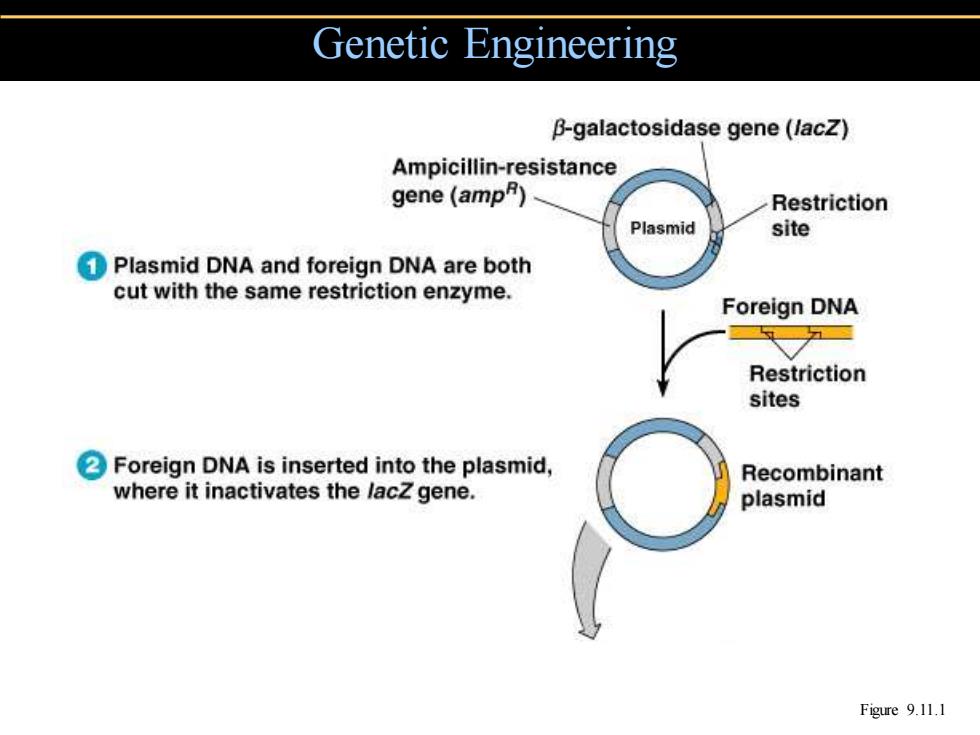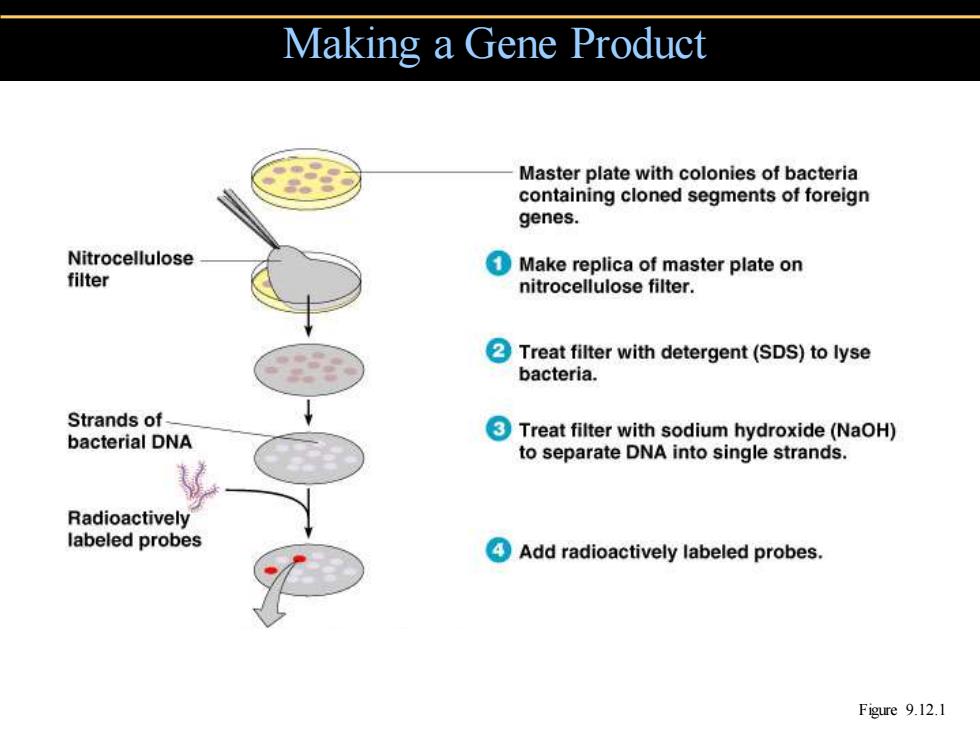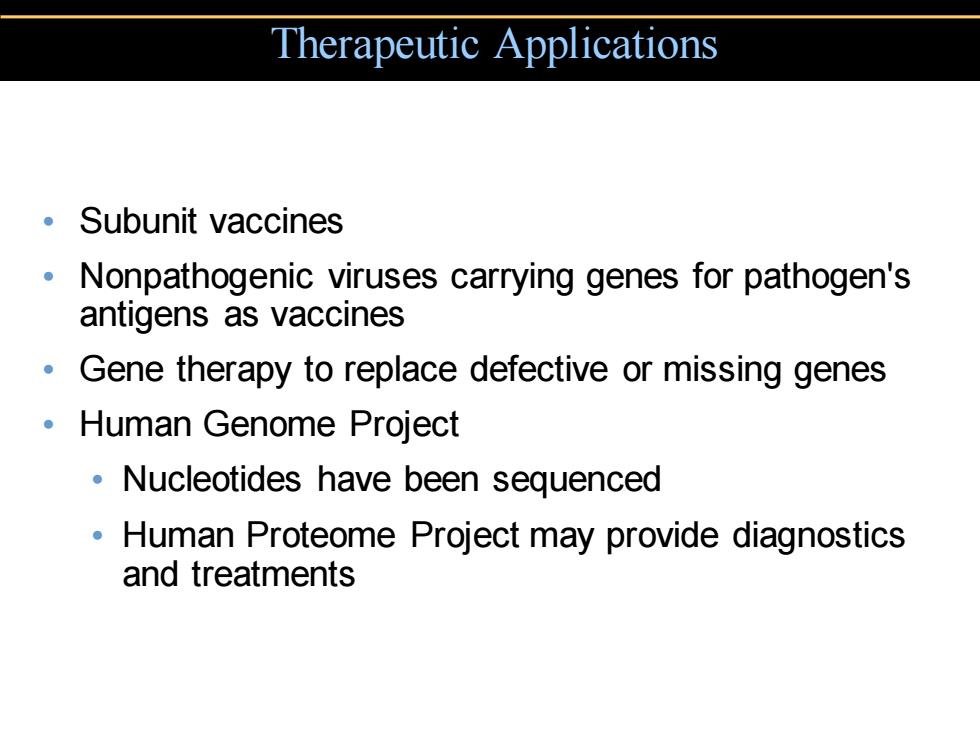
Chapter 9,part B Biotechnology and Recombinant DNA
Copyright © 2004 Pearson Education, Inc., publishing as Benjamin Cummings B.E Pruitt & Jane J. Stein Chapter 9, part B Biotechnology and Recombinant DNA

Genetic Engineering B-galactosidase gene (lacZ) Ampicillin-resistance gene(ampR) Restriction Plasmid site Plasmid DNA and foreign DNA are both cut with the same restriction enzyme. Foreign DNA Restriction sites Foreign DNA is inserted into the plasmid, Recombinant where it inactivates the lacZ gene. plasmid Figure 9.11.1
Genetic Engineering Figure 9.11.1

Genetic Engineering The recombinant plasmid is introduced into a bacterium,which becomes Bacterium ampicillin-resistant. All treated bacteria are spread on a nutrient agar plate containing ampicillin and B-galactosidase substrate,and incubated. White colonies that appear must contain foreign DNA.Blue colonies must not contain foreign DNA. Figure 9.11.2
Genetic Engineering Figure 9.11.2

Making a Gene Product Master plate with colonies of bacteria containing cloned segments of foreign genes. Nitrocellulose Make replica of master plate on filter nitrocellulose filter. Treat filter with detergent(SDS)to lyse bacteria. Strands of bacterial DNA Treat filter with sodium hydroxide(NaOH) to separate DNA into single strands. Radioactively labeled probes Add radioactively labeled probes. Figure 9.12.1
Making a Gene Product Figure 9.12.1

Making a Gene Product Bound Gene of interest DNA Probe will hybridize with desired gene from probe Single-stranded bacterial cells. DNA Developed film Wash filter to remove unbound probe and expose filter to X-ray film. Colonies containing genes of interest Developed film is compared with replica of master plate to identify colonies containing Replica plate gene of interest. Figure 9.12.2
Making a Gene Product Figure 9.12.2

E.coli Used because it is easily grown and its genomics are known Need to eliminate endotoxin from products Cells must be lysed to get product
• Used because it is easily grown and its genomics are known • Need to eliminate endotoxin from products • Cells must be lysed to get product E. coli

Making a Gene Product Figure 9.13
Making a Gene Product Figure 9.13

Therapeutic Applications 。Subunit vaccines 。 Nonpathogenic viruses carrying genes for pathogen's antigens as vaccines Gene therapy to replace defective or missing genes 。Human Genome Project Nucleotides have been sequenced Human Proteome Project may provide diagnostics and treatments
• Subunit vaccines • Nonpathogenic viruses carrying genes for pathogen's antigens as vaccines • Gene therapy to replace defective or missing genes • Human Genome Project • Nucleotides have been sequenced • Human Proteome Project may provide diagnostics and treatments Therapeutic Applications

Random Shotgun Sequencing Sequence DNA fragments Assemble sequences Isolate DNA ■■■■ Fragment DNA with restriction enzymes Edit Clone DNA sequences; in a Bacterial ACTGTTC fill in gaps Artificial Chromosome BAC (a)Construct a gene library (b)Random sequencing (c)Closure phase Figure 9.14
Random Shotgun Sequencing Figure 9.14

Scientific Applications E.coli isolates from Understanding of patients who drank E.coli isolates from contaminated juice DNA patients whose infections were Apple juice not juice related isolates ·Sequencing organisms' genomes DNA fingerprinting for identification Figure 9.16
• Understanding of DNA • Sequencing organisms' genomes • DNA fingerprinting for identification Scientific Applications Figure 9.16